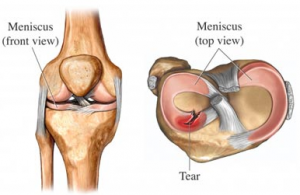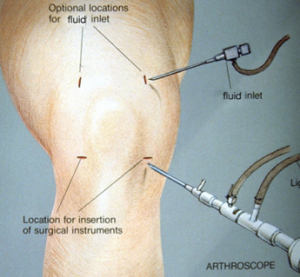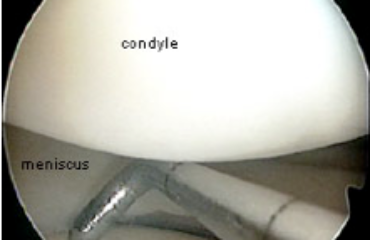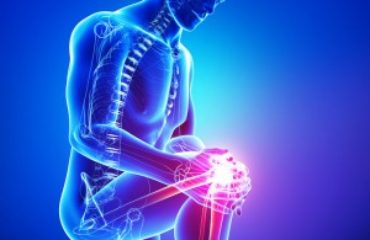Meniscal Tear
Meniscal injuries are the most common type of knee injuries. Meniscus tears are usually related to trauma, but they can occur from a sudden twist or repeated squatting.
How common are meniscal tears?
In a study involving 100 patients with suspected meniscal tears, researchers found meniscal tears in 57 patients  with symptoms, and in 36 asymptomatic knees. The researchers concluded that horizontal tears may not always be related to symptoms. The prevalence rate is 61 cases per 100,000 people, and the male-to-female incidence is 2.5:1. For men, these injuries are more likely to occur during the third decade of life, and for women, during the teen years.
with symptoms, and in 36 asymptomatic knees. The researchers concluded that horizontal tears may not always be related to symptoms. The prevalence rate is 61 cases per 100,000 people, and the male-to-female incidence is 2.5:1. For men, these injuries are more likely to occur during the third decade of life, and for women, during the teen years.
What are the symptoms associated with a meniscal tear?
The symptoms of a meniscal tear include:
- Pain localized to the joint line.
- Clicking, locking, pinching, or catching of the knee.
- Swelling may come on several hours or days after the initial injury.
- Decreased range of motion of the knee joint.
What causes a torn meniscus?
Tearing of the meniscus can occur from any activity that causes the person to forcefully twist or rotate the knee, such as sudden turns and stops and aggressive pivoting. Deep squatting, kneeling, or lifting something heavy can also cause the meniscus to tear. For older people, degenerative changes of the knee can contribute to a torn meniscus.
How is a meniscal tear diagnosed?
When you go to the Scottsdale orthopedic doctor, he will ask you questions about your symptoms and take a detailed medical history. After a thorough physical examination, the doctor will order some tests. These include:
- X-rays – Conducted to view the bones of the knee joint.
- Magnetic resonance imaging (MRI) scan – This is used to confirm a torn meniscus.
Are there different kinds of meniscal tears?
Meniscal tears are graded based on the MRI results. Grading includes:
- Grade I – Small area of tearing.
- Grade II – Linear tear that does not extend to an articulating surface.
- Grade III – Severe tear that reaches the edge/surface of the meniscus.
- Root tears – Meniscal extrusion of a minimum of 3 mm in the mid-coronal plan.
How are meniscal tears treated?
The treatment of meniscal tears depends on the grading of the tear. Options include:
- RICE protocol – Rest, ice packs, compression bandage, and elevation.
- Nonsteroidal anti-inflammatory drugs (NSAIDs) – These include naproxen, ketoprofen, and ibuprofen.
- Arthroscopy – This is a simple surgical procedure used for diagnostic and therapeutic reasons. The doctor can diagnose the tear with 100% accuracy, and small surgical instruments are used to repair the damage.
- Partial meniscectomy – For small tears in the avascular section of the meniscus, removal of a portion of the structure may be necessary.
- Meniscus repair – This is done for tears of the vascular region that are longer than one centimeter, as well as for root tears and tears that involve 50% thickness or more.
- Physical therapy – The therapist works with the patient, teaching stretching and strengthening exercises. Pain relief measures include heat/cold therapy, ultrasound, and electrical stimulation.
Are meniscus repair surgeries effective?
According to a study comparing arthroscopic meniscectomy and open surgery, around 90% of patients reported satisfaction with the arthroscopic procedure compared to 68% with the open procedure. Results from another study found that around 85% of patients were able to return to their pre-injury level of activities.
Dr. Adam Farber is the Board Certified sports medicine specialist at Phoenix Shoulder and Knee. He offers state-of-the-art, minimally invasive procedures for knee injuries such as meniscal tears. Patients are seen from a broad area due to his expertise including Phoenix, Scottsdale, Gilbert, Mesa, Chandler and more. Call today!
Resources
Bin SI, Kim JM, Shin SJ. Radial tears of the posterior horn of the medial meniscus. Arthroscopy. 2004 Apr. 20(4):373-8.
Burks RT, Metcalf MH, Metcalf RW. Fifteen-year follow-up of arthroscopic partial meniscectomy. Arthroscopy. 1997;13:673–679.
Jaureguito JW, Elliot JS, Lietner T, Dixon LB, Reider B. The effects of arthroscopic partial lateral meniscectomy in an otherwise normal knee: a retrospective review of functional, clinical, and radiographic results. Arthroscopy. 1995;11:29–36.
Zanetti M, Pfirrmann CW, Schmid MR, et al. (2003). Patients with suspected meniscal tears: prevalence of abnormalities seen on MRI of 100 symptomatic and 100 contralateral asymptomatic knees. Am J Roentgenol, 181(3):635-41.



